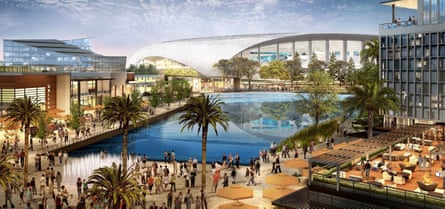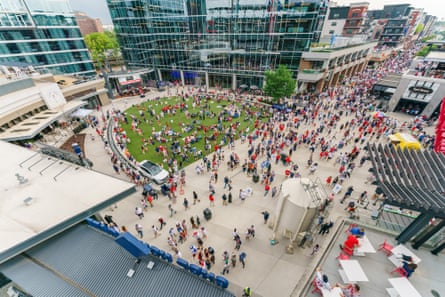‘The stadium is secondary’: how US sports teams became real-estate speculators
PStan Kroenke itched his vision to move the St. Louis Rams into a state-of-the-art stadium that would anchor a massive land redevelopment near Los Angeles International Airport, telling his fellow NFL owners: “This is what we do”.
Nearly eight years later, with the Rams successfully relocated and playing in the $5 billion, 70,240-seat SoFi Stadium complex, Kroenke is making good on his statement with the help of retailers, homebuilders, Taylor Swift and Bad Bunny.
Its 298-acre Hollywood Park property also features a man-made lake, a 6,000-seat theater and space for millions of square feet of offices, hotels, shops, restaurants and apartments. The NFL Network has moved next door to the stadium rapidly gentrifying Inglewood and luxury apartments are ready to rent.
Nowadays everyone does this. More than ever, sports franchises are a real estate play as owners look to boost revenue amid rising costs in a period of high inflation.
Mixed-use developments where people can live, work, shop, dine, drink and play have become ubiquitous as teams try to squeeze as much profit out of their land as possible. The old paradigm was to build a new stadium housing high-end facilities to cater to the corporate set, increase match-day revenues and attract showpiece events such as Super Bowls, World Cup matches and blockbuster concerts from stars like Swift.
Now teams also want to dictate how dollars are spent every day on the streets around their venues, a trend that is turning billionaire sports owners into influential city planners.
A pioneer has settled in the city Kroenke was desperate to escape: the St. Louis Cardinals opened Ballpark village, a dining and entertainment district centered around Busch Stadium, about a decade ago. The Atlanta Braves and Texas Rangers followed suit with their new ballparks; the Houston Astros, Tampa Bay Rays, Arizona Diamondbacks, Kansas City Royals and New York Mets are among other MLB teams with similar ideas.
The NFL's Green Bay Packers opened a district called Title city next to Lambeau Field in 2017. The Packers said this year that Titletown apartments and townhomes were almost fully occupied and that the project's appeal helped them land the 2025 NFL draft. “The three-day event is expected to have a statewide economic impact of approximately $94 million,” the club said“or the equivalent of several Packers home games in the regular season.”

Kroenke funded his plans privately, but by promising to revitalize a neighborhood with projects that typically include public green spaces, providing financial incentives like tax breaks or funding infrastructure improvements makes it more attractive to municipal leaders and voters who may be wary are for providing subsidies worth potentially hundreds of euros. millions of dollars to billionaires.
Steve Cohen, the owner of the Mets, who is estimated to be worth around $20 billion Forbesneeds approval from New York lawmakers to realize its ambition to turn parking lots next to Citi Field into an $8 billion, 50-acre site “sports and entertainment park”. centered on a Hard Rock casino. The NFL's Jacksonville Jaguars — who regularly play in London — are pushing for a $2 billion stadium and mixed-use development program that would require about a billion dollars in taxpayer money. called up a grand blueprint for a downtown Florida renaissance.
One of the proposals for a new Oakland A's stadium was a $1 billion stadium amid $12 billion residential and commercial space. project on the water. After negotiations collapsed, MLB owners agreed in November that the team can move to Las Vegas, where a new stadium will likely be located next to a new Bally's casino resort. sports themed attraction. But with just under nine hectares available for the stadium, and the Strip not exactly lacking in entertainment options, the question is whether the club will be able to benefit from external activities.
In contrast, Robert Kraft, owner of the New England Patriots and New England Revolution, opened a shopping center in 2007 in a parking lot next to the lonely Gillette Stadium, which is about 25 miles from downtown Boston and Providence. Patriot Place attracts more than nine million people every year, according to a report from WGRZwhile last season the Patriots drew a total of 527,024 fans to their regular season home games.
Most owners, says Victor Matheson, an economics professor at the College of the Holy Cross in Massachusetts, “understand that having an entertainment district that generates money 365 days a year is much better than the model of a walled fortress surrounded by a moat with parking lots. ', which is used a few times a year. “NFL parking lots are about the worst possible use of real estate imaginable,” he adds. “You much prefer a stadium in a densely populated area where you can always make money.”
However, urban stadiums are often surrounded by private companies that directly benefit from the team's presence, but not the other way around. “The Chicago Cubs don't benefit from you buying a beer at Murphy's Bleachers or the Cubby Bear,” two beloved bars next to Wrigley Field, Matheson says. This increases the incentive for teams to monitor economic activity in their environment.
Matheson and colleagues investigated stadium use and found that in an average year, NFL, MLB and MLS venues typically host fewer than five major events outside of the anchor tenant's regular season games. MLB teams play a minimum of 81 home games per year, and NBA and NHL franchises often share versatile indoor arenas. NFL teams only host eight or nine regular season games, and that's where Swift comes into the picture.
a fiscal study of Levi's Stadium on behalf of the San Francisco 49ers claims that the two concerts Swift performed at the venue in July had an economic impact on Santa Clara County of $33.5 million, or $16.75 million per performance – a comparable amount as the NFL games mentioned in the report.
after newsletter promotion

Swift performed 53 US concerts this year for her Eras Tour, all in NFL stadiums. Billboard linked the average ticket price for $252. Six were at SoFi, helping both the Rams and the broader local economy. SoFi then welcomed Beyoncé for three nights in September. Dozens of performances have taken place since opening in 2020, and the Rolling Stones, Green Day and Kenny Chesney are booked for next year.
Kroenke, married to billionaire Walmart heiress Ann Walton Kroenke, is also a ranch baron. With 1.6 million hectares – twice the size of Rhode Island – he is the fifth largest landowner in the U.S. The 76-year-old was a real estate developer before becoming a sports owner and building shopping centers next to Walmarts. But sports teams are even more attractive anchor properties than grocery stores.
In the 1990s he founded Kroenke Sports and Entertainment (KSE). Today it owns the Rams, the Denver Nuggets, the Colorado Avalanche, the Colorado Rapids and Arsenal, among others.
The Avalanche and Nuggets play at Ball Arena in downtown Denver. It is surrounded by parking lots ripe for repurposing, with KSEs views image of the concrete surface that has been replaced by a forest of tower blocks and parks. Kroenke too linked to the River Mile, another major redevelopment plan in the neighborhood that aims to connect downtown with a new “stadium district” next to Empower Field at Mile High. That's the home of the Denver Broncos, the NFL franchise that was bought last year by a group led by Rob Walton, a relative of Ann and also an heir to Walmart. Kroenke too considering the long-awaited development in somber stretches around the Rapids' home, Dick's Sporting Goods Park, in Commerce City, between downtown Denver and the international airport.
SoFi is state-of-the-art, indoor and centrally located in the nation's show business capital and second largest metropolitan area. It is one of the busiest NFL stadiums. This year's calendar features more than twenty non-NFL events, from Wrestlemania to Billy Joel and Stevie Nicks, the Concacaf Gold Cup to Ed Sheeran.
But megastars like Swift and Bad Bunny are extremely lucrative, and if you add in the Rams and the LA Chargers — another NFL team sharing the stadium — that's still fewer than 45 major events in a year. And while NFL franchises share 40% of their ticket revenue with the rest of the league, it's possible Swift is leading a much higher percentage. Since SoFi's price tag has more than doubled from initial estimates, Reportedly As for what prompted Kroenke to borrow $900 million from the NFL and $2 billion from a bank, he likely has enough debt to pay off.
However, 10 miles from downtown LA and four miles from LAX airport, with the LA Clippers' $2 billion basketball arena set to further turbocharge Inglewood's rising real estate prices when it opens in 2024, the value of all that land will only increase.
“It's hard to imagine that (SoFi) is a great investment. He uses that stadium to open the door,” Matheson said. “What you're really trying to do is monetize the mixed-use development and you use the stadium as a way to free up all the land for you; Actually, the stadium is your secondary concern.” That's what Kroenke does.
